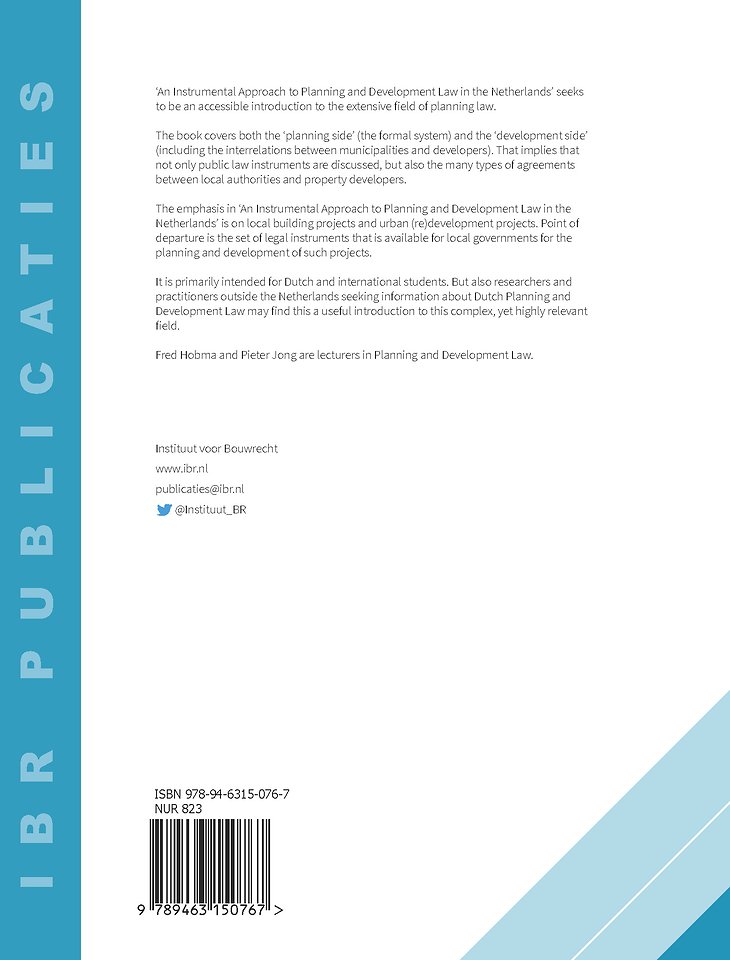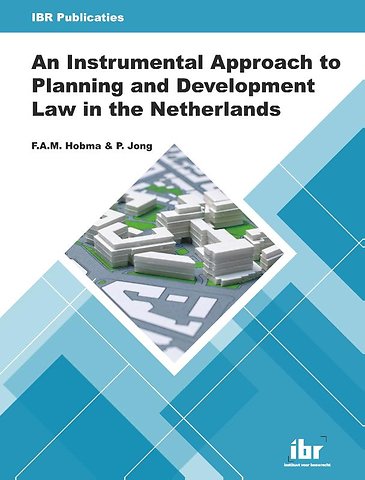An Instrumental Approach to Planning and Development Law in the Netherlands
Paperback Engels 2022 1e druk 9789463150767Samenvatting
‘An Instrumental Approach to Planning and Development Law in the Netherlands’ seeks to be an accessible introduction to the extensive field of planning law. The book covers both the ‘planning side’ (the formal system) and the ‘development side’ (including the interrelations between municipalities and developers). That implies that not only public law instruments are discussed, but also the many types of agreements between local authorities and property developers.
The emphasis in ‘An Instrumental Approach to Planning and Development Law in the Netherlands’ is on local building projects and urban (re)development projects. Point of departure is the set of legal instruments that is available for local governments for the planning and development of such projects.
It is primarily intended for Dutch and international students. But also researchers and practitioners outside the Netherlands seeking information about Dutch Planning and Development Law may find this a useful introduction to this complex, yet highly relevant field. Fred Hobma and Pieter Jong are lecturers in Planning and Development Law.
Trefwoorden
ruimtelijke ordening omgevingswet planrecht ontwikkelingsrecht bestuursrecht gebouwde omgeving eigendomsrechten nederland wetgeving juridische instrumenten omgevingsvergunning publiek-private samenwerking vastgoedontwikkeling milieurecht stedelijke ontwikkeling kostenverhaal onteigening grondbeleid voorkeursrecht bestemmingsplan overheid erfgoed projectbesluit milieubescherming tender subsidies
Trefwoorden
Specificaties
Lezersrecensies
Inhoudsopgave
U kunt van deze inhoudsopgave een PDF downloaden
List of figures xiii
Chapter 1 - Planning Powers
1.1 Constitutional state 1
1.2 Legality: the origins of planning powers 2
1.3 Democracy 3
1.4 Law as instrument and as legal protection 4
1.5 Historic development of planning powers 5
1.6 Types of planning powers: reactive and proactive 7
1.6.1 Reactive powers 7
1.6.2 Proactive powers 7
1.7 Distribution of planning powers 8
1.7.1 Reasons for distribution of powers 8
1.7.2 Territorial distribution: provinces and municipalities 8
1.8 EU planning powers 9
1.9 Public law and private law planning instruments 10
1.9.1 Differences between public law and private law 10
1.9.2 The thwarting doctrine 11
1.9.3 Compliance with the general principles of proper administration 12
1.10 Financial powers 13
Chapter 2 - Planning and Property Rights
2.1 Property rights as human rights 15
2.2 Property rights under Dutch law 16
2.2.1 Property rights in the Dutch Civil Code 16
2.2.2 Limitation of property rights 17
2.2.3 Taking away of property 19
2.3 Right to develop and development rights 19
2.4 The power of landownership 21
2.5 Property rights debate 23
2.6 The core legal issue for developers 23
2.7 Mutual dependency 24
Chapter 3 - Classification of Legal Instruments
3.1 The rationale for a classification 27
3.2 Four types of instruments 28
3.2.1 Instruments and how they affect market (trans)actions 28
3.2.2 Market shaping tools 31
3.2.3 Market regulating tools 31
3.2.4 What are legal instruments? 32
3.2.5 Market stimulating tools 34
3.2.6 Capacity building tools 35
3.3 The usefulness of a classification of legal instruments by impact on market behaviour 37
3.4 Specific instruments within each type 38
3.5 The sequence of instruments 40
Chapter 4 - Environmental Strategy
4.1 Purpose of an environmental strategy 43
4.2 Procedure and binding effect 44
4.3 The environmental strategy as a shaping and legal instrument 45
Chapter 5 - Masterplan and other Urban Designs
5.1 Purpose of a masterplan 47
5.2 Legal meaning of a masterplan 49
5.3 Procedure of a masterplan 50
5.4 From non-binding masterplan to binding physical environment plan 50
5.5 The masterplan and other urban designs as shaping and legal instrument 51
Chapter 6 - The Physical Environment Plan
6.1 Introduction 53
6.2 Legally binding effects of a physical environment plan 53
6.3 Characteristics of the procedure of a physical environment plan 55
6.4 Functions of a physical environment plan 57
6.5 A balanced assignment of functions to sites 57
6.5.1 Function descriptions 57
6.5.2 Realisation of functions that are in conflict with existing land-use 58
6.6 Physical environment plan activities 59
6.7 Partial hierarchy 59
6.8 Social housing 60
6.9 Legal protection 62
6.9.1 Stages of challenges 62
6.9.2 Scope of judicial review 62
6.9.3 Judgments 64
6.10 Deviation from a physical environment plan 64
6.11 The physical environment plan as regulating and legal instrument 65
Chapter 7 - Environmental Permit
7.1 Fundamentals of permit systems in spatial planning and construction 67
7.1.1 Introduction 67
7.1.2 Principle 67
7.1.3 Instrument 68
7.1.4 Principle of legality 68
7.1.5 General interest 68
7.1.6 Testing 68
7.1.7 Decisions 69
7.1.8 Terms and Conditions 69
7.1.9 Charges 69
7.1.10 Complaints 69
7.1.11 Privatisation of assessment of permit applications 70
7.2 One permit for different activities 70
7.3 Permit-free structures 72
7.4 Permit preparation procedures 72
7.5 The environmental permit for a construction activity 74
7.5.1 Assessment framework 74
7.5.2 Technical requirements 75
7.5.3 Notification instead of permit 75
7.6 The environmental permit for a physical environment plan activity 78
7.6.1 Inner plan physical environment plan activity 78
7.6.2 Outer plan physical environment plan activity (1) 79
7.6.3 Outer plan physical environment plan activity (2) 80
7.7 Legal protection 83
7.7.1 Participation 83
7.7.2 Appeal and higher appeal 84
7.8 The environmental permit as regulating and legal instrument 85
Chapter 8 - Project Decision
8.1 The significance of law in infrastructure planning procedures 87
8.2 European law influences on infrastructure planning procedures 88
8.3 Speeding-up of infrastructure decision-making procedures 89
8.4 Procedural aspects of a project decision 90
8.4.1 Mandatory project decision 90
8.4.2 Steps in the procedure for a project decision 90
8.4.3 Appeal 94
8.5 The project decision as a regulating and legal instrument 95
Chapter 9 - Cost Recovery
9.1 What is cost recovery? 97
9.2 Four ways of cost recovery 98
9.3 Cost recovery through the sales price of land 98
9.4 Cost recovery through ground rent 99
9.5 Cost recovery through an agreement 99
9.6 Cost recovery through physical environment plan or environmental permit 101
9.7 International comparison 103
9.8 Cost recovery as regulating and legal instrument 103
Chapter 10 - Environmental Protection Instruments
10.1 Introduction 105
10.2 General research obligations 108
10.2.1 Responsibility of the initiator 108
10.2.2 General legal requirements 109
10.2.3 Responsible use of policy room 109
10.2.4 Balanced allocation of functions 111
10.3 Environmental Impact Assessment 112
10.3.1 Introduction 112
10.3.2 EIA in case of plans (SEA) 113
10.3.3 EIA in case of projects 114
10.3.4 Annex V 115
10.4 Various environmental quality assessments 117
10.4.1 Introduction 117
10.4.2 Structure of the rest of this chapter 117
10.5 Soil quality assessment 117
10.5.1 Introduction 117
10.5.2 Explanation 117
10.6 Water assessment 119
10.6.1 Introduction 119
10.6.2 Explanation 119
10.7 Air quality assessment 121
10.7.1 Introduction 121
10.7.2 Explanation 122
10.8 Noise assessment 123
10.8.1 Introduction 123
10.8.2 Explanation 123
10.9 Nature assessment 126
10.9.1 Introduction 126
10.9.2 Explanation 127
10.10 External safety assessment 129
10.10.1 Introduction 129
10.10.2 Explanation 130
10.11 Environmental protection instruments as regulating and legal instruments 133
Chapter 11 - Listed Buildings and Urban Conservation Areas
11.1 Introduction 135
11.2 Listed buildings 136
11.2.1 Nationally listed buildings 136
11.2.2 Municipally listed buildings 138
11.3 Listed urban conservation areas 139
11.4 World heritage 140
11.5 Listed buildings and urban conservation areas as regulating and legal instruments 142
Chapter 12 - Design Code
12.1 Public law and private law regulation of visual quality 143
12.2 The design code 144
12.3 Applications of a design code 144
12.3.1 Public law application 144
12.3.2 Private law applications 145
12.4 The design code as regulating and legal instrument 146
Chapter 13 - Pre-emption Rights
13.1 The purpose of pre-emption rights 149
13.2 Legal effect of the pre-emption right 150
13.3 Procedural aspects 151
13.4 Compensation 152
13.5 The pre-emption right as stimulating and legal instrument 153
Chapter 14 - Expropriation
14.1 Taking away of property 155
14.2 Procedural aspects 156
14.3 Expropriation for infrastructure and urban development 158
14.4 Compensation 159
14.5 Self-realisation 161
14.6 Expropriation as stimulating and legal instrument 163
Chapter 15 - Land Acquisition
15.1 Ownership of real property for planning reasons 165
15.2 Active land policy 166
15.3 Reasons for governmental acquisition of land and buildings 168
15.4 Land acquisition by private property developers 169
15.5 Land acquisition as stimulating and legal instrument 170
Chapter 16 - Land Sale and Ground Lease
16.1 Allotment of land 171
16.2 Conditions of land sale or ground lease 171
16.3 Ground lease 174
16.3.1 Characteristics of ground lease 174
16.3.2 Reasons for ground lease 175
16.4 Land sale and ground lease as stimulating and legal instruments 176
Chapter 17 - Tenders
17.1 What is a tender? 179
17.2 Advantages and disadvantages 181
17.3 Partner selection 182
17.4 Legal requirement to organise competition when selling land 183
17.5 Tender as a stimulating and legal instrument 184
Chapter 18 - Public-Private Partnerships
18.1 Definition and reasons for existence 185
18.2 Public-private partnership: declaration of intent 188
18.3 Public-private partnership: partnership agreements 189
18.4 Public-private partnership models 191
18.5 Public-private partnership: land development companies 193
18.6 The physical environment plan agreement 195
18.6.1 The physical environment plan as a means (of power) 195
18.6.2 Development control planning 196
18.6.3 Contents and ratio of physical environment plan agreements 196
18.6.4 Binding effect of physical environment plan agreements 198
18.6.5 Position of third parties 198
18.7 Public-private partnerships as stimulating and legal instrument 199
Chapter 19 - Subsidies and Funds
19.1 What are subsidies? 201
19.2 Subsidy from governmental body to governmental body 202
19.3 Subsidy from governmental body to developer 203
19.4 Municipal funds 204
19.5 Subsidies and funds as stimulating and legal instruments 204
Glossary 207
Index 215
Anderen die dit boek kochten, kochten ook
Rubrieken
- advisering
- algemeen management
- coaching en trainen
- communicatie en media
- economie
- financieel management
- inkoop en logistiek
- internet en social media
- it-management / ict
- juridisch
- leiderschap
- marketing
- mens en maatschappij
- non-profit
- ondernemen
- organisatiekunde
- personal finance
- personeelsmanagement
- persoonlijke effectiviteit
- projectmanagement
- psychologie
- reclame en verkoop
- strategisch management
- verandermanagement
- werk en loopbaan








